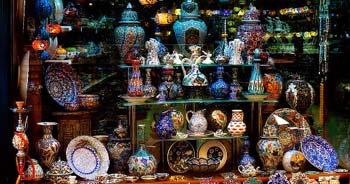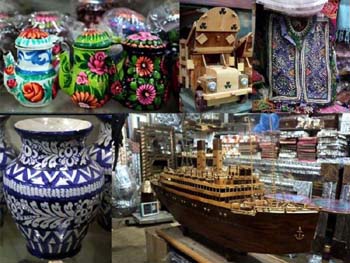
KP women famous across globe for handicrafts
Asmat Shah Garwaki
Peshawar: Taslim Bibi, a senior citizen of 65 years age, decided to open a handicraft skills center at her home with hope of financial support and also to impart skill to others, but due to financial constraints she could not continue her plan.

Sitting on the wood wreckage on the main road in front of Sunday Bazar in Hayatabad Township of Peshawar, Taslim Bibi said that she was resident of Zargarabad Wazir Bagh Peshawar and making handicrafts for the last 40 years.
She said that her husband died six years ago adding she had two sons and two daughters of which one daughter was married.
She said that a government sponsored skill development initiative focusing on empowering people through active participation in art and cultural activities and enhancing economic growth through creative industries helped her gain successful skill development and capacity building.
Taslim Bibi claimed that she made different things with dissimilar designs like handkerchiefs, blankets, bed sheets, caps, sweaters, socks and other items and sold those there .
“I have the ability to make two caps a day and sell each for rupees 100 to 150 ,” she remarked. “I use two needles of Kureshi in my work”, she added while sharing her way of preparation of handicrafts,she said. “I earn 500 rupees to 1000 per day which is maximum income for my family , ” she expressed the pleasure.
Taslim Bibi said that it has especially helped females in becoming empowered and earn the respect of their families as they were now making financial contributions towards family expenses along with male household members. “Learning any skill is the best way to help support a family by earning livelihood,” said Taslim Bibi.
She said that she took keen interest in the work and was able to timely carry out any order placed; Moreover she said that she loved it that she could conveniently sit and work at her home also.
It was her first priority to extend the skill to others she said adding, it was much better than washing dishes in others’ houses and begging, she said.
Former Chairperson Handicraft Association of Pakistan Maryam Iqbal said that Turkey has made a lot of development in handicraft and Khyber Pakhtunkhwa people have expertise in this field so there should be exchange of handmade products between the two countries to promote the business. She demanded this during a meeting with Pakistani Deputy Counselor General Saleem Ullah Khan Niazi in Istanbul.
She said that the women of KP were famous across the globe for handmade products. She expressed the hope that if both countries take effective steps to showcase these products and ensure handicraft display in their embassies that would help in increasing business of handicrafts.
The Deputy Counselor General Saleem Ullah Khan Niazi had assured Maryam Iqbal that he would cooperate in promoting handicrafts and would do everything possible to promote the craft industry. Assistant Director Culture Khyber Pakhtunkhwa, Riaz Khan said that the art of handmade creation is an old practice of humanity.
The roots of which can be traced in the primitive societies.
The known examples of such creativity are the stone tools of different varieties that the primitive man made from the easily available sources, he added.
They stucked for the first time a specific stone with another one and the flakes and blades were detected for cutting the hunted animals or removing their skins.
However, the actual handicrafts were those produced in the bronze age era of Mehrgarh and Indus valley civilization when the people of the time also added aesthetic expression in terms of different shapes and designs with colors and engraving tools to their mud and metal ceramics and other household objects.
The stone beads with various magical and geometrical patterns of Buddhist period are the prominent examples for adoration and religious purposes. Despite the development of sophisticated technology in the modern world which produces electronic and automatic households, the importance of handicrafts is equally continuing and plays a vital role in the lives of human beings.
Riaz Khan said the significance of handcrafts is evident from the facts that UN’s specialized agency UNESCO has declared the cultural goods as an effective tool for the global economic growth and achieving the sustainable development goals agenda of 2015-2030.
He said handcrafts or cultural goods have multiple roles in a society. Besides the routine utility in people’s lives, it also acts as a vehicle for carrying further the values, customs, traditions and history of a society and transmitting it from one generation to another. Copper work, woodwork, shawl making, Kadhar work, embroidery, jewelry, pottery etc are the famous examples of KP’s handmade creativity Riaz Khan added.
Raiz Khan said that KP Culture Department was taking measures to highlight the skills of KP across the world and establish exhibitions across the country to create awareness among masses. The KP Culture department had sent some traditional items to an exhibition held in the United Kingdom two years ago and had declared Peshawar (KP) as a creative city internationally. “KP handicraft center has been established in Islamabad which would be operationalised soon that would highlight the KP’s skill nationally and internationally and would sell out through e-commerce across the globe,” he said.
Similarly, a large number of visitors, including locals and foreigners, thronged the Khyber Pakhtunkhwa Pavilion to have a glimpse of cultural and traditional handicrafts displayed at the Lok Virsa annual exhibition held last week.
The Khyber Pakhtunkhwa Culture and Tourism Authority (KP-CTA) had established the Khyber Pakhtunkhwa Pavilion at the Lok Virsa to showcase the cultural and traditional handicrafts and tourism potential to attract more tourists to the province.
Visitors evinced keen interest in the tourism potential including scenic places, archaeological and heritage sites and cultural and traditional handicrafts.
Visiting the KP Pavilion, foreigners expressed their commendation and about the traditional handicrafts in the visitors’ book.
